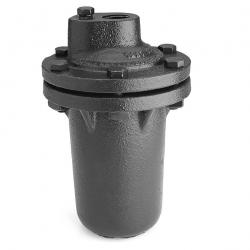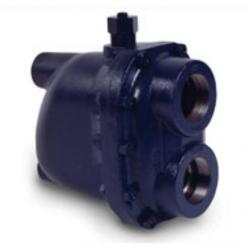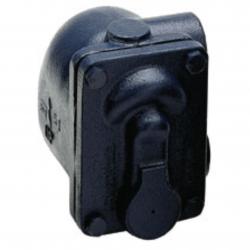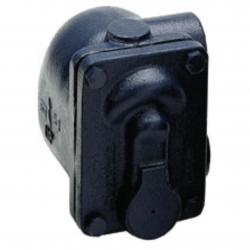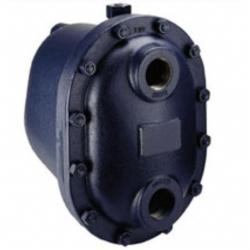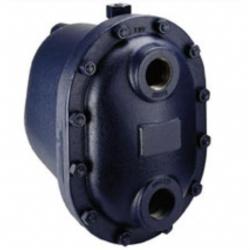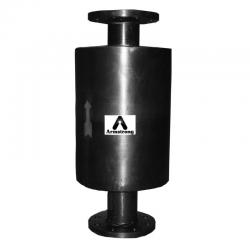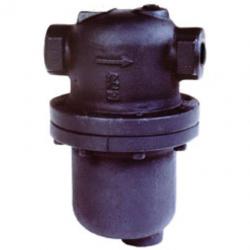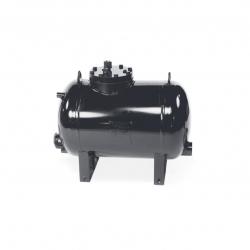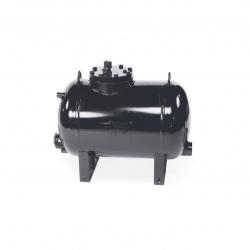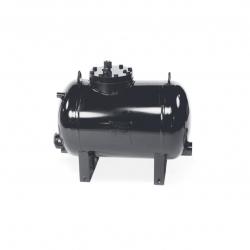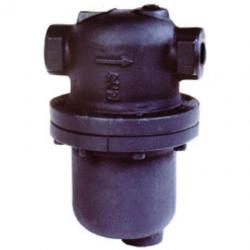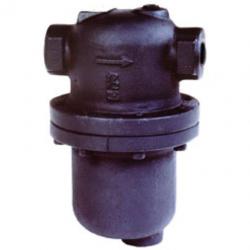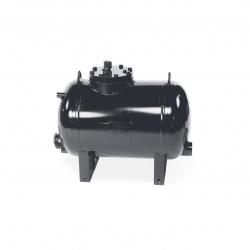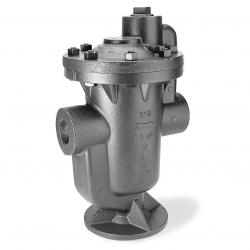2"
Armstrong International
View:
Active Filters :
- Brand: Armstrong International
- Alt. Size: 2"
Part #:713366
-
Y-Type Cast Iron Strainers
250 lb Screwed 1/2"-3" Class 125 Flanged 2"-6" Class 250 Flanged 2"-6"
Screen chambers won't leak or crush
Both ends of the chambers are precisely machined. This means perfectly round and smooth seating surfaces, as well as a fixed chamber length. Since the screen seats snugly on the machined surface, no particle bigger than the screen opening can escape around the end of the screen.
Screwed retainers easy in, easy out
Straight threads mean it takes less torque to achieve a tight seal with proper gasket compression. Less torque is also required to remove the retainer. For you, that means less danger of "freezing in" than with hard-to-break tapered pipe threads.
Off-center blowdown connections for better dirt removal
Off-center drains on 2-1/2" and 3" strainers allow you to remove liquid and dirt nearly completely when blowing down the strainer. Also, less liquid will spill when the screen retainer is removed.
Many screen choices
Many screen materials, meshes and perforations are available.
Qty:
Part #:501-C5295-1
- Inverted Bucket Steam TrapsEnergy efficient because it's so reliable
The inverted bucket is the most reliable steam trap operating principle known. The heart of its simple design is a unique leverage system that multiplies the force provided by the bucket to open the valve against pressure.
Since the bucket is open at the bottom, it resists damage from water hammer, and wear points are heavily reinforced for long life. The inverted bucket has only two moving parts-the valve lever assembly and the bucket. That means no fixed points, no complicated linkage. Nothing to stick, bind or clog.
Conserves energy even in the presence of wear
Armstrong inverted bucket steam traps open and close based on the difference in density between condensate and steam-the inverted bucket principle. They open and close gently, minimizing wear. This simple fact means that inverted buckets are subject to less wear than some other types of traps.
In fact, as an Armstrong inverted bucket trap wears, its tight seal actually improves. The valve and seat of the Armstrong trap provide essentially line contact-resulting in a tight seal because the entire closing force is concentrated on one narrow seating ring.
An Armstrong inverted bucket steam trap continues to operate efficiently with use. Gradual wear slightly increases the diameter of the seat and alters the shape and diameter of the valve. But, as this occurs, a tight seal is still preserved-the ball merely seats itself more deeply.
Corrosion-resistant parts
The stainless steel valve and seat of the Armstrong inverted bucket steam trap are individually ground and lapped together in matched sets. All other working parts are wear- and corrosion-resistant stainless steel.
Venting of air and CO2
The Armstrong inverted bucket provides continuous automatic air and CO2 venting with no cooling lag or threat of air binding.
Operation against back pressure
The Armstrong inverted bucket has excellent performance against back pressure. It has no adverse effect on inverted bucket operation other than to reduce its capacity by the low differential. The bucket simply requires less force to pull the valve open and cycle the trap.
Freedom from dirt problems
Armstrong designed its inverted bucket to be virtually free of dirt problems. The valve and seat are at the top of the trap, far away from the larger particles of dirt, which fall to the bottom. Here, the up-and-down action of the bucket pulverizes them.
Since the valve of an inverted bucket is either fully closed or open, dirt particles pass freely. And the swift flow of condensate from under the bucket's edge creates a unique self-scrubbing action that sweeps dirt out of the trap.
Qty:
Part #:501-C6123
- Automatic Differential Condensate Controllers
Armstrong automatic differential condensate controllers (DC) are designed to function on applications where condensate must be lifted from a drain point or in gravity drainage applications where increased velocity will aid in condensate drainage.
Lifting condensate from the drain pointoften referred to as siphon drainagereduces the pressure of the condensate, causing a portion of it to flash into steam. Since ordinary steam traps are unable to distinguish flash steam from live steam, they close and impeded drainage.
Increased velocity with gravity drainage will aid in drawing the condensate and air to the DC. An internal steam bypass controlled by a manual metering valve causes this increased velocity. Therefore, the condensate controller automatically vents the bypass or secondary steam. This steam is then collected for use in other heat exchangers or discharged to the condensate return line.
Capacity considerations for draining equipment vary greatly, according to the application. However, a single condensate controller provides sufficient capacity for most applications..
How they work
Condensate, air and steam (live and flash) enter through the controller inlet. At this point, flash steam and air are automatically separated from the condensate. Then they divert into the integral bypass at a controlled rate, forming secondary steam.
The valve is adjustable so it matches the amount of flash present under full capacity operation or to meet the velocity requirements of the system. The condensate discharges through a separate orifice by the inverted bucket.
Because of the dual-orifice design, there is a preset controlled pressure differential for the secondary steam system, while maximum pressure differential is available to discharge the condensate.
Qty:
Part #:501-C6124
- Float and Thermostatic (F&T) Steam TrapsThe More Your Steam Pressure Varies, The More You Need Armstrong F&T TrapsWhen steam pressure may vary from maximum steam supply pressure to vacuum, Armstrong F&Ts are your most energy-efficient choice. Our line of F&Ts brings Armstrong performance, dependability and long life to trapping services requiring continuous drainage with high air venting capacity. Thanks to separate orifices for condensate and air, they provide continuous condensate drainage and air venting-even under conditions of zero pressure.
All the benefits detailed here have been designed into Armstrong F&Ts through long experience in the manufacture of pressure float-type traps. They assure you of optimum operating efficiency for long periods with minimum trouble.
How they work
Float and thermostatic traps are mechanical units that operate on both density and temperature principles. The float valve operates on the density principle. A level connects the ball float to the valve and seat. Once condensate reaches a certain level in the trap, the float rises, opening the orifice and draining condensate. A water seal formed by the condensate prevents live steam loss.
Since the discharge valve is under water, it is not capable of venting air and non-condensables. When the accumulation of air and con-condensable gases causes a significant temperature drop, a thermostatic air vent in the top of the trap discharges them. The thermostatic vent opens at a temperature a few degrees below saturation, so it's able to handle a large volume of air-through an entirely separate orifice-but at a slightly reduced temperature.
Built as tough as the jobs they do
Armstrong float and thermostatic traps are unique in their super heavy duty construction. Armstrong uses high quality ASTM A48 Class 30 cast iron or ASTM A216 WCB cast steel-normally found in pressure vessels rated to 250 psi (17 bar) or 465 psi (32 bar). Internal mechanisms are made from stainless steel and are heavily reinforced. No brass cotter pins here. Valves and seats are stainless steel, hardened, ground and lapped to withstand the erosive forces of flashing condensate.
Why go to all this trouble for traps normally recommended for low-pressure, modulating service? The operative word here is modulating. Modulating pressures mean widely varying loads, thermal cycling and high air and non-condensable gas loads.
In other words tough service. Inferior, lightweight construction in this kind of service is a mistake waiting to happen. Trap failures on modulating pressure may lead to water hammer, corrosion and even damage to heat exchangers.
Armstrong's published capacities are based on actual measurements of traps handling hot, flashing condensate. Competitive F&Ts may utilize theoretical calculated capacities. Armstrong uses its own steam lab to give you actual capacity-especially important on high-capacity traps such as those in our ultra-capacity line. Not only does Armstrong offer super heavy duty construction for long life and reliability, but we also supply the data to back up performance. Here's a simple, easy-to-remember summary The more your pressure varies, the more you need Armstrong F&Ts.
Qty:
Part #:501-C6125
- Automatic Differential Condensate Controllers
Armstrong automatic differential condensate controllers (DC) are designed to function on applications where condensate must be lifted from a drain point or in gravity drainage applications where increased velocity will aid in condensate drainage.
Lifting condensate from the drain pointoften referred to as siphon drainagereduces the pressure of the condensate, causing a portion of it to flash into steam. Since ordinary steam traps are unable to distinguish flash steam from live steam, they close and impeded drainage.
Increased velocity with gravity drainage will aid in drawing the condensate and air to the DC. An internal steam bypass controlled by a manual metering valve causes this increased velocity. Therefore, the condensate controller automatically vents the bypass or secondary steam. This steam is then collected for use in other heat exchangers or discharged to the condensate return line.
Capacity considerations for draining equipment vary greatly, according to the application. However, a single condensate controller provides sufficient capacity for most applications..
How they work
Condensate, air and steam (live and flash) enter through the controller inlet. At this point, flash steam and air are automatically separated from the condensate. Then they divert into the integral bypass at a controlled rate, forming secondary steam.
The valve is adjustable so it matches the amount of flash present under full capacity operation or to meet the velocity requirements of the system. The condensate discharges through a separate orifice by the inverted bucket.
Because of the dual-orifice design, there is a preset controlled pressure differential for the secondary steam system, while maximum pressure differential is available to discharge the condensate.
Qty:
Part #:501-D1175-13
- Float and Thermostatic (F&T) Steam TrapsThe More Your Steam Pressure Varies, The More You Need Armstrong F&T TrapsWhen steam pressure may vary from maximum steam supply pressure to vacuum, Armstrong F&Ts are your most energy-efficient choice. Our line of F&Ts brings Armstrong performance, dependability and long life to trapping services requiring continuous drainage with high air venting capacity. Thanks to separate orifices for condensate and air, they provide continuous condensate drainage and air venting-even under conditions of zero pressure.
All the benefits detailed here have been designed into Armstrong F&Ts through long experience in the manufacture of pressure float-type traps. They assure you of optimum operating efficiency for long periods with minimum trouble.
How they work
Float and thermostatic traps are mechanical units that operate on both density and temperature principles. The float valve operates on the density principle. A level connects the ball float to the valve and seat. Once condensate reaches a certain level in the trap, the float rises, opening the orifice and draining condensate. A water seal formed by the condensate prevents live steam loss.
Since the discharge valve is under water, it is not capable of venting air and non-condensables. When the accumulation of air and con-condensable gases causes a significant temperature drop, a thermostatic air vent in the top of the trap discharges them. The thermostatic vent opens at a temperature a few degrees below saturation, so it's able to handle a large volume of air-through an entirely separate orifice-but at a slightly reduced temperature.
Built as tough as the jobs they do
Armstrong float and thermostatic traps are unique in their super heavy duty construction. Armstrong uses high quality ASTM A48 Class 30 cast iron or ASTM A216 WCB cast steel-normally found in pressure vessels rated to 250 psi (17 bar) or 465 psi (32 bar). Internal mechanisms are made from stainless steel and are heavily reinforced. No brass cotter pins here. Valves and seats are stainless steel, hardened, ground and lapped to withstand the erosive forces of flashing condensate.
Why go to all this trouble for traps normally recommended for low-pressure, modulating service? The operative word here is modulating. Modulating pressures mean widely varying loads, thermal cycling and high air and non-condensable gas loads.
In other words tough service. Inferior, lightweight construction in this kind of service is a mistake waiting to happen. Trap failures on modulating pressure may lead to water hammer, corrosion and even damage to heat exchangers.
Armstrong's published capacities are based on actual measurements of traps handling hot, flashing condensate. Competitive F&Ts may utilize theoretical calculated capacities. Armstrong uses its own steam lab to give you actual capacity-especially important on high-capacity traps such as those in our ultra-capacity line. Not only does Armstrong offer super heavy duty construction for long life and reliability, but we also supply the data to back up performance. Here's a simple, easy-to-remember summary The more your pressure varies, the more you need Armstrong F&Ts.
Qty:
Part #:501-D1175-14
- Float and Thermostatic (F&T) Steam TrapsThe More Your Steam Pressure Varies, The More You Need Armstrong F&T TrapsWhen steam pressure may vary from maximum steam supply pressure to vacuum, Armstrong F&Ts are your most energy-efficient choice. Our line of F&Ts brings Armstrong performance, dependability and long life to trapping services requiring continuous drainage with high air venting capacity. Thanks to separate orifices for condensate and air, they provide continuous condensate drainage and air venting-even under conditions of zero pressure.
All the benefits detailed here have been designed into Armstrong F&Ts through long experience in the manufacture of pressure float-type traps. They assure you of optimum operating efficiency for long periods with minimum trouble.
How they work
Float and thermostatic traps are mechanical units that operate on both density and temperature principles. The float valve operates on the density principle. A level connects the ball float to the valve and seat. Once condensate reaches a certain level in the trap, the float rises, opening the orifice and draining condensate. A water seal formed by the condensate prevents live steam loss.
Since the discharge valve is under water, it is not capable of venting air and non-condensables. When the accumulation of air and con-condensable gases causes a significant temperature drop, a thermostatic air vent in the top of the trap discharges them. The thermostatic vent opens at a temperature a few degrees below saturation, so it's able to handle a large volume of air-through an entirely separate orifice-but at a slightly reduced temperature.
Built as tough as the jobs they do
Armstrong float and thermostatic traps are unique in their super heavy duty construction. Armstrong uses high quality ASTM A48 Class 30 cast iron or ASTM A216 WCB cast steel-normally found in pressure vessels rated to 250 psi (17 bar) or 465 psi (32 bar). Internal mechanisms are made from stainless steel and are heavily reinforced. No brass cotter pins here. Valves and seats are stainless steel, hardened, ground and lapped to withstand the erosive forces of flashing condensate.
Why go to all this trouble for traps normally recommended for low-pressure, modulating service? The operative word here is modulating. Modulating pressures mean widely varying loads, thermal cycling and high air and non-condensable gas loads.
In other words tough service. Inferior, lightweight construction in this kind of service is a mistake waiting to happen. Trap failures on modulating pressure may lead to water hammer, corrosion and even damage to heat exchangers.
Armstrong's published capacities are based on actual measurements of traps handling hot, flashing condensate. Competitive F&Ts may utilize theoretical calculated capacities. Armstrong uses its own steam lab to give you actual capacity-especially important on high-capacity traps such as those in our ultra-capacity line. Not only does Armstrong offer super heavy duty construction for long life and reliability, but we also supply the data to back up performance. Here's a simple, easy-to-remember summary The more your pressure varies, the more you need Armstrong F&Ts.
Qty:
Part #:501-D17207
- Float and Thermostatic (F&T) Steam TrapsThe More Your Steam Pressure Varies, The More You Need Armstrong F&T TrapsWhen steam pressure may vary from maximum steam supply pressure to vacuum, Armstrong F&Ts are your most energy-efficient choice. Our line of F&Ts brings Armstrong performance, dependability and long life to trapping services requiring continuous drainage with high air venting capacity. Thanks to separate orifices for condensate and air, they provide continuous condensate drainage and air venting-even under conditions of zero pressure.
All the benefits detailed here have been designed into Armstrong F&Ts through long experience in the manufacture of pressure float-type traps. They assure you of optimum operating efficiency for long periods with minimum trouble.
How they work
Float and thermostatic traps are mechanical units that operate on both density and temperature principles. The float valve operates on the density principle. A level connects the ball float to the valve and seat. Once condensate reaches a certain level in the trap, the float rises, opening the orifice and draining condensate. A water seal formed by the condensate prevents live steam loss.
Since the discharge valve is under water, it is not capable of venting air and non-condensables. When the accumulation of air and con-condensable gases causes a significant temperature drop, a thermostatic air vent in the top of the trap discharges them. The thermostatic vent opens at a temperature a few degrees below saturation, so it's able to handle a large volume of air-through an entirely separate orifice-but at a slightly reduced temperature.
Built as tough as the jobs they do
Armstrong float and thermostatic traps are unique in their super heavy duty construction. Armstrong uses high quality ASTM A48 Class 30 cast iron or ASTM A216 WCB cast steel-normally found in pressure vessels rated to 250 psi (17 bar) or 465 psi (32 bar). Internal mechanisms are made from stainless steel and are heavily reinforced. No brass cotter pins here. Valves and seats are stainless steel, hardened, ground and lapped to withstand the erosive forces of flashing condensate.
Why go to all this trouble for traps normally recommended for low-pressure, modulating service? The operative word here is modulating. Modulating pressures mean widely varying loads, thermal cycling and high air and non-condensable gas loads.
In other words tough service. Inferior, lightweight construction in this kind of service is a mistake waiting to happen. Trap failures on modulating pressure may lead to water hammer, corrosion and even damage to heat exchangers.
Armstrong's published capacities are based on actual measurements of traps handling hot, flashing condensate. Competitive F&Ts may utilize theoretical calculated capacities. Armstrong uses its own steam lab to give you actual capacity-especially important on high-capacity traps such as those in our ultra-capacity line. Not only does Armstrong offer super heavy duty construction for long life and reliability, but we also supply the data to back up performance. Here's a simple, easy-to-remember summary The more your pressure varies, the more you need Armstrong F&Ts.
Qty:
Part #:501-D17208
- Float and Thermostatic (F&T) Steam TrapsThe More Your Steam Pressure Varies, The More You Need Armstrong F&T TrapsWhen steam pressure may vary from maximum steam supply pressure to vacuum, Armstrong F&Ts are your most energy-efficient choice. Our line of F&Ts brings Armstrong performance, dependability and long life to trapping services requiring continuous drainage with high air venting capacity. Thanks to separate orifices for condensate and air, they provide continuous condensate drainage and air venting-even under conditions of zero pressure.
All the benefits detailed here have been designed into Armstrong F&Ts through long experience in the manufacture of pressure float-type traps. They assure you of optimum operating efficiency for long periods with minimum trouble.
How they work
Float and thermostatic traps are mechanical units that operate on both density and temperature principles. The float valve operates on the density principle. A level connects the ball float to the valve and seat. Once condensate reaches a certain level in the trap, the float rises, opening the orifice and draining condensate. A water seal formed by the condensate prevents live steam loss.
Since the discharge valve is under water, it is not capable of venting air and non-condensables. When the accumulation of air and con-condensable gases causes a significant temperature drop, a thermostatic air vent in the top of the trap discharges them. The thermostatic vent opens at a temperature a few degrees below saturation, so it's able to handle a large volume of air-through an entirely separate orifice-but at a slightly reduced temperature.
Built as tough as the jobs they do
Armstrong float and thermostatic traps are unique in their super heavy duty construction. Armstrong uses high quality ASTM A48 Class 30 cast iron or ASTM A216 WCB cast steel-normally found in pressure vessels rated to 250 psi (17 bar) or 465 psi (32 bar). Internal mechanisms are made from stainless steel and are heavily reinforced. No brass cotter pins here. Valves and seats are stainless steel, hardened, ground and lapped to withstand the erosive forces of flashing condensate.
Why go to all this trouble for traps normally recommended for low-pressure, modulating service? The operative word here is modulating. Modulating pressures mean widely varying loads, thermal cycling and high air and non-condensable gas loads.
In other words tough service. Inferior, lightweight construction in this kind of service is a mistake waiting to happen. Trap failures on modulating pressure may lead to water hammer, corrosion and even damage to heat exchangers.
Armstrong's published capacities are based on actual measurements of traps handling hot, flashing condensate. Competitive F&Ts may utilize theoretical calculated capacities. Armstrong uses its own steam lab to give you actual capacity-especially important on high-capacity traps such as those in our ultra-capacity line. Not only does Armstrong offer super heavy duty construction for long life and reliability, but we also supply the data to back up performance. Here's a simple, easy-to-remember summary The more your pressure varies, the more you need Armstrong F&Ts.
Qty:
Part #:501-D25974
- DS Series In-Line Condensate SeparatorsDuctile Iron Drain SeparatorCondensate in steam and air piping reduces thermal efficiency, causes water hammer, corrodes equipment such as valves and pipes, and causes other problems.
In-line (drain) separators DS-1, DS-2, DS-3, and DS-4 separate condensate efficiently by using the centrifugal force of steam or air created by introducing it into a specifically shaped path. Because of the simple structure of the drain separators, pressure loss is minimized, enabling clean, dry steam or air to be fed to equipment.
When steam or air flow enters the drain separator, centrifugal force is generated in the fluid because of the devices internal structural design. The fluid drains along the wall because of the difference in specific gravity with steam or air, eventually striking the baffle. The baffle guides the fluid to the drain outlet and to the trap, which drains it. As a result, small dirt particles and condensate are separated and removed from the system through the bottom drain.
• Cyclone structure maximizes liquid separation efficiency
• Pressure loss is extremely low
• No moving parts means no breakdowns
Qty:
Part #:501-D27087
- AEH Series Exhaust Heads Armstrongs AEH series carbon steel exhaust heads should be used when there is a risk of water carryover up an atmospheric vent pipe. The internal knock-out plate and stainless steel mesh screening effectively contains water carry-over and discharges it through the bottom drain leaving dry flash steam to vent through the top of the vessel.
Connections
• Flanged ASME B16.5 CL 150
• Drain FNPT
Qty:
Part #:501-D33860
- DS Series In-Line Condensate SeparatorsCarbon Steel Drain SeparatorCondensate in steam and air piping reduces thermal efficiency, causes water hammer, corrodes equipment such as valves and pipes, and causes other problems.
In-line (drain) separators DS-1, DS-2, DS-3, and DS-4 separate condensate efficiently by using the centrifugal force of steam or air created by introducing it into a specifically shaped path. Because of the simple structure of the drain separators, pressure loss is minimized, enabling clean, dry steam or air to be fed to equipment.
When steam or air flow enters the drain separator, centrifugal force is generated in the fluid because of the devices internal structural design. The fluid drains along the wall because of the difference in specific gravity with steam or air, eventually striking the baffle. The baffle guides the fluid to the drain outlet and to the trap, which drains it. As a result, small dirt particles and condensate are separated and removed from the system through the bottom drain.
• Cyclone structure maximizes liquid separation efficiency
• Pressure loss is extremely low
• No moving parts means no breakdowns
Qty:
Part #:501-D33861
- DS Series In-Line Condensate SeparatorsCarbon Steel Drain SeparatorCondensate in steam and air piping reduces thermal efficiency, causes water hammer, corrodes equipment such as valves and pipes, and causes other problems.
In-line (drain) separators DS-1, DS-2, DS-3, and DS-4 separate condensate efficiently by using the centrifugal force of steam or air created by introducing it into a specifically shaped path. Because of the simple structure of the drain separators, pressure loss is minimized, enabling clean, dry steam or air to be fed to equipment.
When steam or air flow enters the drain separator, centrifugal force is generated in the fluid because of the devices internal structural design. The fluid drains along the wall because of the difference in specific gravity with steam or air, eventually striking the baffle. The baffle guides the fluid to the drain outlet and to the trap, which drains it. As a result, small dirt particles and condensate are separated and removed from the system through the bottom drain.
• Cyclone structure maximizes liquid separation efficiency
• Pressure loss is extremely low
• No moving parts means no breakdowns
Qty:
Part #:501-D345-1A
- Pumping TrapsArmstrong pump traps offer the following features, advantages and benefits
Non-electric
Utilizes inexpensive steam, air or gas for operation and has no seals, motors, impellers or electric components, which frequently fail.
Wear and corrosion resistance.
Mechanism frame assembly is constructed of rugged investment-cast stainless steel components.
Stress chloride corrosion resistance
Inconel X-750 springs have higher resistance to the stress that causes lower-grade stainless steel springs to fail.
Corrosion resistance
Entire float mechanism is stainless steel. Float is Heliarc welded to avoid the introduction of dissimilar metals, which could lead to galvanic corrosion and float failure.
Externally replaceable valve and seat assembly
Maintenance is a "snap" with hardened stainless steel valves that can be cleaned or replaced without cap removal.
Explosion proof
Intrinsically safe due to all-stainless steel construction of mechanism.
Long life and dependable service.
Simple float/spring operation and rugged all-stainless steel construction allow for long, trouble-free service life.
Compact, low-profile design
Low-profile design allows for maximum pump capacity with minimal fill head and floor space requirements. PT-300 Series horizontal tank design provides the highest capacity with the lowest profile on the market.
Qty:
Part #:501-D345-1B
- Pumping TrapsArmstrong pump traps offer the following features, advantages and benefits
Non-electric
Utilizes inexpensive steam, air or gas for operation and has no seals, motors, impellers or electric components, which frequently fail.
Wear and corrosion resistance.
Mechanism frame assembly is constructed of rugged investment-cast stainless steel components.
Stress chloride corrosion resistance
Inconel X-750 springs have higher resistance to the stress that causes lower-grade stainless steel springs to fail.
Corrosion resistance
Entire float mechanism is stainless steel. Float is Heliarc welded to avoid the introduction of dissimilar metals, which could lead to galvanic corrosion and float failure.
Externally replaceable valve and seat assembly
Maintenance is a "snap" with hardened stainless steel valves that can be cleaned or replaced without cap removal.
Explosion proof
Intrinsically safe due to all-stainless steel construction of mechanism.
Long life and dependable service.
Simple float/spring operation and rugged all-stainless steel construction allow for long, trouble-free service life.
Compact, low-profile design
Low-profile design allows for maximum pump capacity with minimal fill head and floor space requirements. PT-300 Series horizontal tank design provides the highest capacity with the lowest profile on the market.
Qty:
Part #:501-D345-1C
- Pumping TrapsArmstrong pump traps offer the following features, advantages and benefits
Non-electric
Utilizes inexpensive steam, air or gas for operation and has no seals, motors, impellers or electric components, which frequently fail.
Wear and corrosion resistance.
Mechanism frame assembly is constructed of rugged investment-cast stainless steel components.
Stress chloride corrosion resistance
Inconel X-750 springs have higher resistance to the stress that causes lower-grade stainless steel springs to fail.
Corrosion resistance
Entire float mechanism is stainless steel. Float is Heliarc welded to avoid the introduction of dissimilar metals, which could lead to galvanic corrosion and float failure.
Externally replaceable valve and seat assembly
Maintenance is a "snap" with hardened stainless steel valves that can be cleaned or replaced without cap removal.
Explosion proof
Intrinsically safe due to all-stainless steel construction of mechanism.
Long life and dependable service.
Simple float/spring operation and rugged all-stainless steel construction allow for long, trouble-free service life.
Compact, low-profile design
Low-profile design allows for maximum pump capacity with minimal fill head and floor space requirements. PT-300 Series horizontal tank design provides the highest capacity with the lowest profile on the market.
Qty:
Part #:501-D345-1D
- Pumping TrapsArmstrong pump traps offer the following features, advantages and benefits
Non-electric
Utilizes inexpensive steam, air or gas for operation and has no seals, motors, impellers or electric components, which frequently fail.
Wear and corrosion resistance.
Mechanism frame assembly is constructed of rugged investment-cast stainless steel components.
Stress chloride corrosion resistance
Inconel X-750 springs have higher resistance to the stress that causes lower-grade stainless steel springs to fail.
Corrosion resistance
Entire float mechanism is stainless steel. Float is Heliarc welded to avoid the introduction of dissimilar metals, which could lead to galvanic corrosion and float failure.
Externally replaceable valve and seat assembly
Maintenance is a "snap" with hardened stainless steel valves that can be cleaned or replaced without cap removal.
Explosion proof
Intrinsically safe due to all-stainless steel construction of mechanism.
Long life and dependable service.
Simple float/spring operation and rugged all-stainless steel construction allow for long, trouble-free service life.
Compact, low-profile design
Low-profile design allows for maximum pump capacity with minimal fill head and floor space requirements. PT-300 Series horizontal tank design provides the highest capacity with the lowest profile on the market.
Qty:
Part #:501-D345-1E
- Pumping TrapsArmstrong pump traps offer the following features, advantages and benefits
Non-electric
Utilizes inexpensive steam, air or gas for operation and has no seals, motors, impellers or electric components, which frequently fail.
Wear and corrosion resistance.
Mechanism frame assembly is constructed of rugged investment-cast stainless steel components.
Stress chloride corrosion resistance
Inconel X-750 springs have higher resistance to the stress that causes lower-grade stainless steel springs to fail.
Corrosion resistance
Entire float mechanism is stainless steel. Float is Heliarc welded to avoid the introduction of dissimilar metals, which could lead to galvanic corrosion and float failure.
Externally replaceable valve and seat assembly
Maintenance is a "snap" with hardened stainless steel valves that can be cleaned or replaced without cap removal.
Explosion proof
Intrinsically safe due to all-stainless steel construction of mechanism.
Long life and dependable service.
Simple float/spring operation and rugged all-stainless steel construction allow for long, trouble-free service life.
Compact, low-profile design
Low-profile design allows for maximum pump capacity with minimal fill head and floor space requirements. PT-300 Series horizontal tank design provides the highest capacity with the lowest profile on the market.
Qty:
Part #:501-D41697
- DS Series In-Line Condensate SeparatorsCarbon Steel Drain SeparatorCondensate in steam and air piping reduces thermal efficiency, causes water hammer, corrodes equipment such as valves and pipes, and causes other problems.
In-line (drain) separators DS-1, DS-2, DS-3, and DS-4 separate condensate efficiently by using the centrifugal force of steam or air created by introducing it into a specifically shaped path. Because of the simple structure of the drain separators, pressure loss is minimized, enabling clean, dry steam or air to be fed to equipment.
When steam or air flow enters the drain separator, centrifugal force is generated in the fluid because of the devices internal structural design. The fluid drains along the wall because of the difference in specific gravity with steam or air, eventually striking the baffle. The baffle guides the fluid to the drain outlet and to the trap, which drains it. As a result, small dirt particles and condensate are separated and removed from the system through the bottom drain.
• Cyclone structure maximizes liquid separation efficiency
• Pressure loss is extremely low
• No moving parts means no breakdowns
Qty:
Part #:501-D42778
- DS Series In-Line Condensate SeparatorsStainless Steel Drain SeparatorCondensate in steam and air piping reduces thermal efficiency, causes water hammer, corrodes equipment such as valves and pipes, and causes other problems.
In-line (drain) separators DS-1, DS-2, DS-3, and DS-4 separate condensate efficiently by using the centrifugal force of steam or air created by introducing it into a specifically shaped path. Because of the simple structure of the drain separators, pressure loss is minimized, enabling clean, dry steam or air to be fed to equipment.
When steam or air flow enters the drain separator, centrifugal force is generated in the fluid because of the devices internal structural design. The fluid drains along the wall because of the difference in specific gravity with steam or air, eventually striking the baffle. The baffle guides the fluid to the drain outlet and to the trap, which drains it. As a result, small dirt particles and condensate are separated and removed from the system through the bottom drain.
• Cyclone structure maximizes liquid separation efficiency
• Pressure loss is extremely low
• No moving parts means no breakdowns
Qty:
Part #:501-D48835
- Pumping TrapsArmstrong pump traps offer the following features, advantages and benefits
Non-electric
Utilizes inexpensive steam, air or gas for operation and has no seals, motors, impellers or electric components, which frequently fail.
Wear and corrosion resistance.
Mechanism frame assembly is constructed of rugged investment-cast stainless steel components.
Stress chloride corrosion resistance
Inconel X-750 springs have higher resistance to the stress that causes lower-grade stainless steel springs to fail.
Corrosion resistance
Entire float mechanism is stainless steel. Float is Heliarc welded to avoid the introduction of dissimilar metals, which could lead to galvanic corrosion and float failure.
Externally replaceable valve and seat assembly
Maintenance is a "snap" with hardened stainless steel valves that can be cleaned or replaced without cap removal.
Explosion proof
Intrinsically safe due to all-stainless steel construction of mechanism.
Long life and dependable service.
Simple float/spring operation and rugged all-stainless steel construction allow for long, trouble-free service life.
Compact, low-profile design
Low-profile design allows for maximum pump capacity with minimal fill head and floor space requirements. PT-300 Series horizontal tank design provides the highest capacity with the lowest profile on the market.
Qty:
Part #:501-D500089
Qty:
Part #:501-D500125
- Inverted Bucket Steam TrapsEnergy efficient because it's so reliable
The inverted bucket is the most reliable steam trap operating principle known. The heart of its simple design is a unique leverage system that multiplies the force provided by the bucket to open the valve against pressure.
Since the bucket is open at the bottom, it resists damage from water hammer, and wear points are heavily reinforced for long life. The inverted bucket has only two moving parts-the valve lever assembly and the bucket. That means no fixed points, no complicated linkage. Nothing to stick, bind or clog.
Conserves energy even in the presence of wear
Armstrong inverted bucket steam traps open and close based on the difference in density between condensate and steam-the inverted bucket principle. They open and close gently, minimizing wear. This simple fact means that inverted buckets are subject to less wear than some other types of traps.
In fact, as an Armstrong inverted bucket trap wears, its tight seal actually improves. The valve and seat of the Armstrong trap provide essentially line contact-resulting in a tight seal because the entire closing force is concentrated on one narrow seating ring.
An Armstrong inverted bucket steam trap continues to operate efficiently with use. Gradual wear slightly increases the diameter of the seat and alters the shape and diameter of the valve. But, as this occurs, a tight seal is still preserved-the ball merely seats itself more deeply.
Corrosion-resistant parts
The stainless steel valve and seat of the Armstrong inverted bucket steam trap are individually ground and lapped together in matched sets. All other working parts are wear- and corrosion-resistant stainless steel.
Venting of air and CO2
The Armstrong inverted bucket provides continuous automatic air and CO2 venting with no cooling lag or threat of air binding.
Operation against back pressure
The Armstrong inverted bucket has excellent performance against back pressure. It has no adverse effect on inverted bucket operation other than to reduce its capacity by the low differential. The bucket simply requires less force to pull the valve open and cycle the trap.
Freedom from dirt problems
Armstrong designed its inverted bucket to be virtually free of dirt problems. The valve and seat are at the top of the trap, far away from the larger particles of dirt, which fall to the bottom. Here, the up-and-down action of the bucket pulverizes them.
Since the valve of an inverted bucket is either fully closed or open, dirt particles pass freely. And the swift flow of condensate from under the bucket's edge creates a unique self-scrubbing action that sweeps dirt out of the trap.
Qty:
Part #:501-D500126
- Inverted Bucket Steam TrapsEnergy efficient because it's so reliable
The inverted bucket is the most reliable steam trap operating principle known. The heart of its simple design is a unique leverage system that multiplies the force provided by the bucket to open the valve against pressure.
Since the bucket is open at the bottom, it resists damage from water hammer, and wear points are heavily reinforced for long life. The inverted bucket has only two moving parts-the valve lever assembly and the bucket. That means no fixed points, no complicated linkage. Nothing to stick, bind or clog.
Conserves energy even in the presence of wear
Armstrong inverted bucket steam traps open and close based on the difference in density between condensate and steam-the inverted bucket principle. They open and close gently, minimizing wear. This simple fact means that inverted buckets are subject to less wear than some other types of traps.
In fact, as an Armstrong inverted bucket trap wears, its tight seal actually improves. The valve and seat of the Armstrong trap provide essentially line contact-resulting in a tight seal because the entire closing force is concentrated on one narrow seating ring.
An Armstrong inverted bucket steam trap continues to operate efficiently with use. Gradual wear slightly increases the diameter of the seat and alters the shape and diameter of the valve. But, as this occurs, a tight seal is still preserved-the ball merely seats itself more deeply.
Corrosion-resistant parts
The stainless steel valve and seat of the Armstrong inverted bucket steam trap are individually ground and lapped together in matched sets. All other working parts are wear- and corrosion-resistant stainless steel.
Venting of air and CO2
The Armstrong inverted bucket provides continuous automatic air and CO2 venting with no cooling lag or threat of air binding.
Operation against back pressure
The Armstrong inverted bucket has excellent performance against back pressure. It has no adverse effect on inverted bucket operation other than to reduce its capacity by the low differential. The bucket simply requires less force to pull the valve open and cycle the trap.
Freedom from dirt problems
Armstrong designed its inverted bucket to be virtually free of dirt problems. The valve and seat are at the top of the trap, far away from the larger particles of dirt, which fall to the bottom. Here, the up-and-down action of the bucket pulverizes them.
Since the valve of an inverted bucket is either fully closed or open, dirt particles pass freely. And the swift flow of condensate from under the bucket's edge creates a unique self-scrubbing action that sweeps dirt out of the trap.
Qty:
Displaying: 1 - 24 of 240 Matching Items



